3D Studio Light Planning
Review: Elixxier set.a.light 3D simulates lighting setups.
9.23.2022
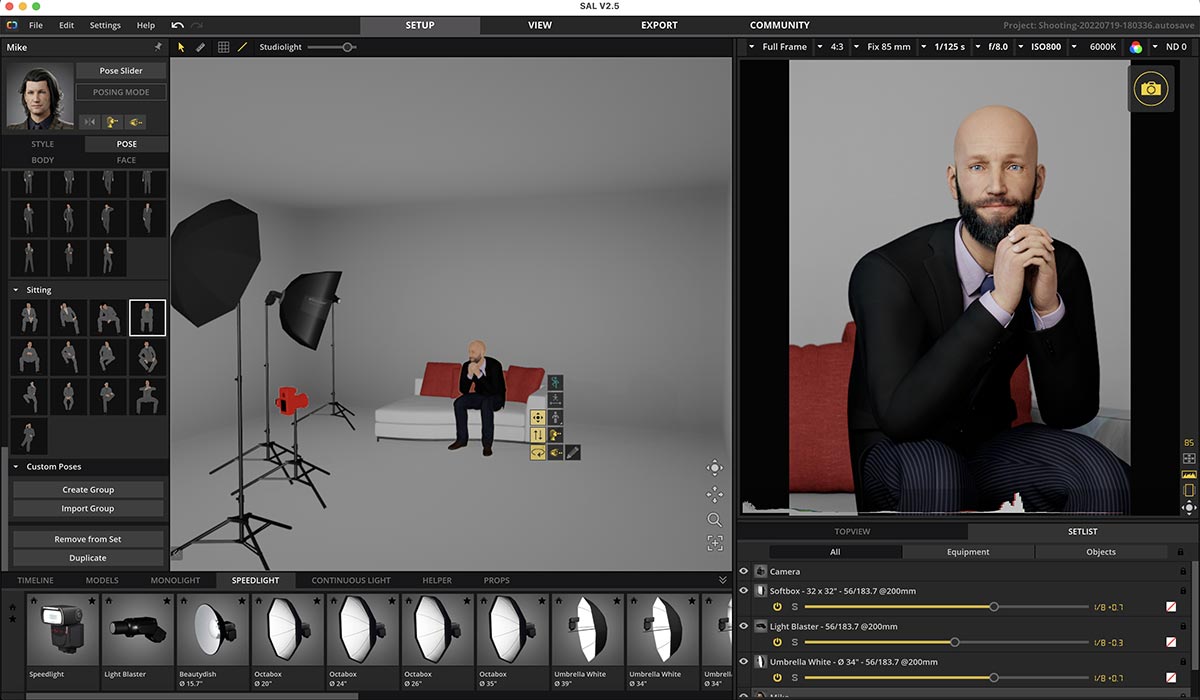
Every once in a while, you stumble upon a software application that has a huge impact on how you work. For me, it was the discovery of Elixxier set.a.light 3D several years ago. Designed to simulate lighting setups, set.a.light 3D’s virtual studio is equipped with everything a still photographer or filmmaker could only dream of wanting in a real studio: cameras, lenses, backdrops, lights and modifiers, models, wardrobes, and props, all with custom options.
The program is perfect for preproduction since you can design and set up an entire shoot without leaving your computer—a real time and money saver if you’re renting studio space. The lighting layout can be saved and printed so you or an assistant can duplicate the setup at the physical studio.
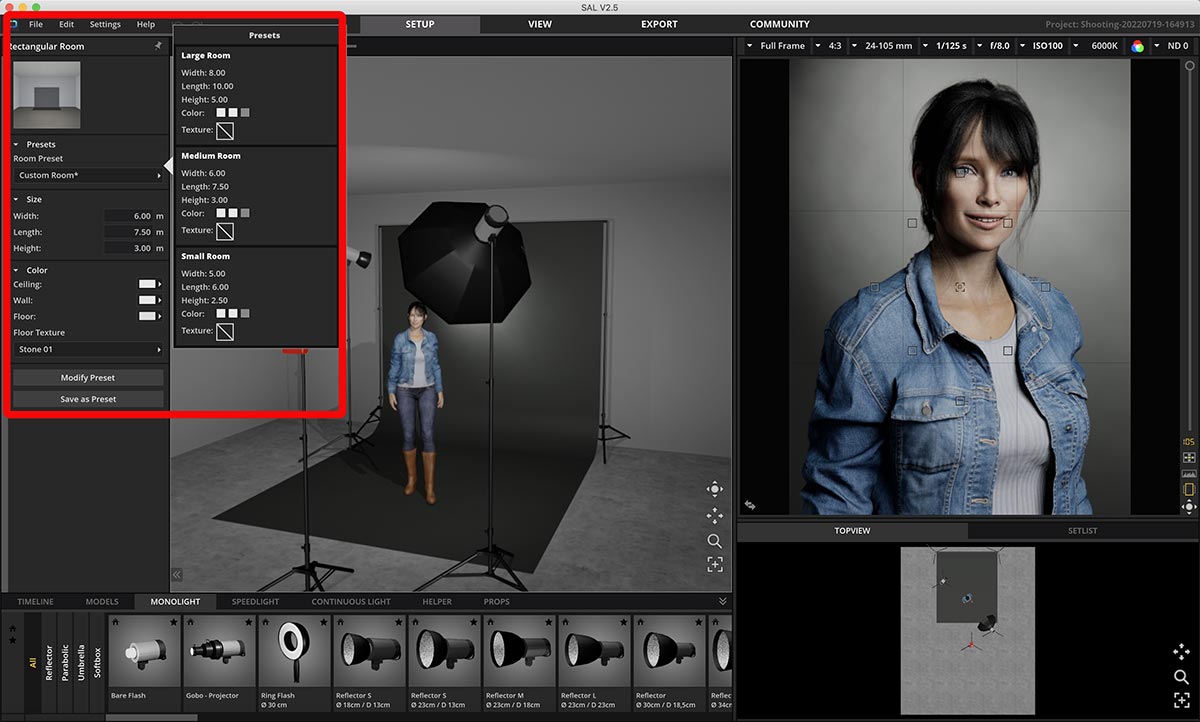
Users can create and save custom rooms.
Elixxier set.a.light 3D is great for experimenting with different lighting scenarios and is an amazing learning tool for people who are just starting to understand studio lighting. As a bonus, Elixxier has an online community where photographers share lighting setups that can be downloaded, providing additional educational and inspirational opportunities.
Cross-platform, the software comes in two versions: Basic ($94) and Studio ($230). Upgrade pricing is also available. The latter version, reviewed here, offers more tools, functionality, and customization. Download a free trial of each to decide which works best for you, but I highly recommend the Studio version.
Now in version 2.5.8, set.a.light 3D has come a long way since its early days thanks in large part to the company’s dedication to regularly providing substantial improvements and additional features.
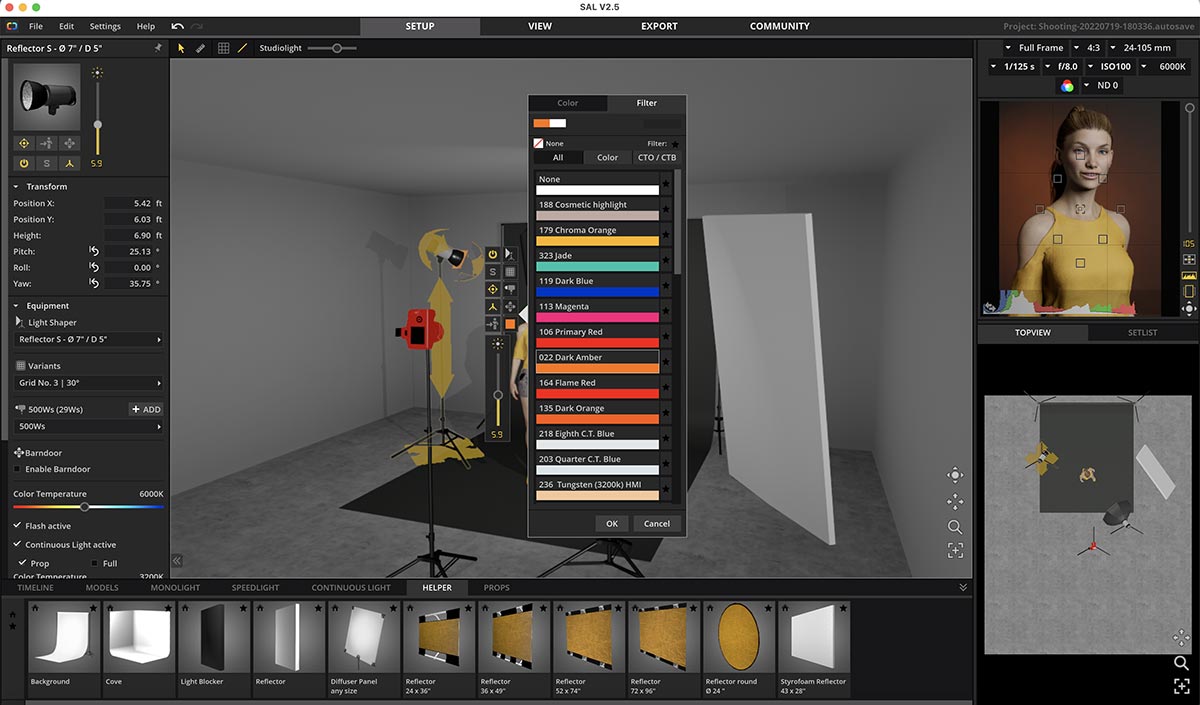
Stock paper backdrop colors from Savage and Colorama are available.
Set Up and System Specs
Installation is quick and easy. The software can be installed on two computers, but only one can be used at a time. It’s important to check your computer’s specifications first. Mac (M1 compatible) and Windows both require at least 8GB RAM (16GB recommended) and a graphics card with a minimum of 2GB VRAM (6GB ideally); the Elixxier website has detailed graphics card specifications. Equally critical for performance are the quality settings for shadow, texture, and render resolution. There’s also a 4K display mode, all of which require the higher end specs for optimal operation. You can opt for speed over quality if you’re running the application on a less powerful machine—it even worked on an early 2015 MacBook Air with 8GB of RAM. But, as expected, the program is most responsive when the recommended specifications are met or exceeded. I did most of the testing for this review on a 2019 MacBook Pro with 64GB of RAM and got much better performance than with an older, less powerful MacBook Air. Elixxier recommends using a mouse for the smoothest navigation, but the program works with tablets, too, including the Wacom Intuos Touch.
The interface features various views and an assortment of on-screen tools to adjust the set elements. You can rotate the set 360 degrees, which makes it easy to ensure that everything is properly placed. In addition to the full set view, another panel provides the angle of view as seen by the camera. An overhead view is also available.
In the Studio version, the default small, medium, and large studio presets can be customized and saved as templates to match any spaces you’re using. Exact measurements of the set—including lighting and camera positions—can be included when you print the set plan to ensure accurate placement in the studio.
The software offers paper backdrop colors from Savage and Colorama, making it easy to match the virtual backdrops in the live studio. Custom colors and sizes can be implemented, and wall colors, ambient lighting, and more can be selected as well. Need a more visually interesting background? Insert a photo of a balmy tropical setting or a cool, snowy mountain scene on the wall behind your subject.
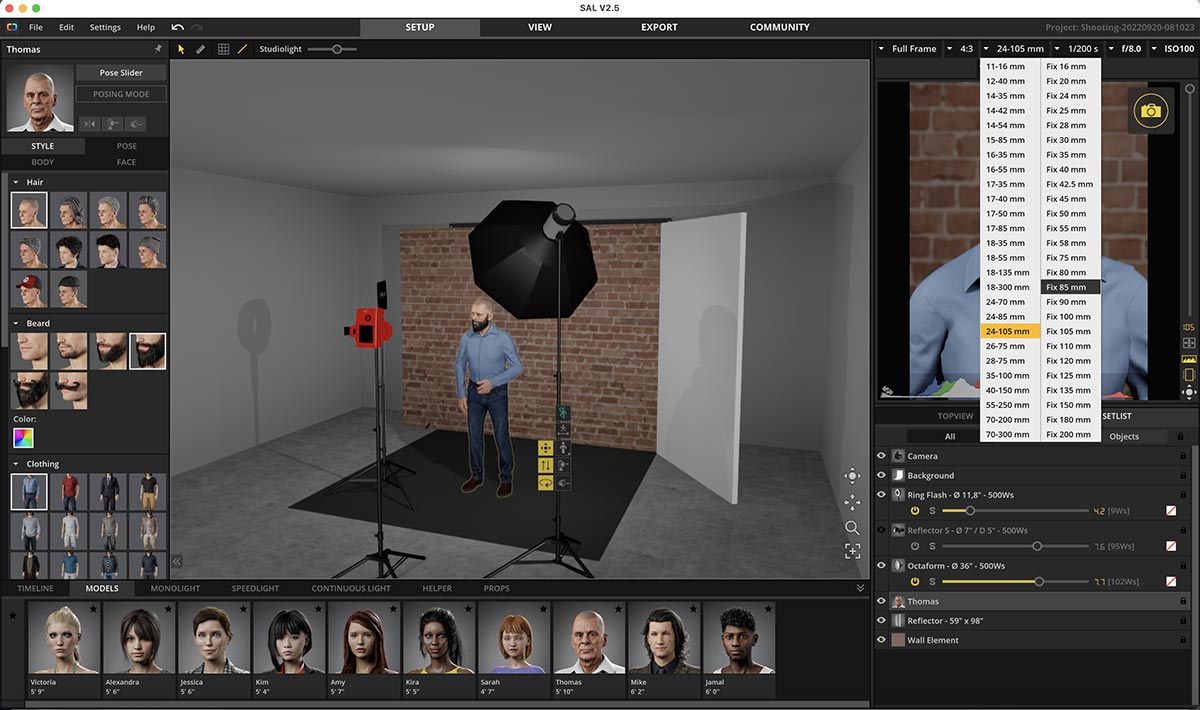
Changing focal lengths is quick and easy with an large selection of prime and zoom lenses.
Cameras and Lenses
A full complement of camera formats (rather than brand names) and lenses are included so you can easily match what’s in your camera bag. In addition to full-frame, the camera options cover every crop factor imaginable, including a trio of APS-C crops, four-thirds/MFT, and 6x6, 4x5, and 8x10 roll film formats. Aspect ratios can be chosen separately. Multiple cameras can be set up to capture various angles. Film and video cameras are available in the prop category. A total of 52 lenses are split between zooms and primes with a range of focal lengths from wide-angle to telephoto.
Exposures are manually selected. Standard options such as shutter speed, aperture, ISO, and white balance are available for still shoots. Film camera settings match those found on video cameras, including fps and shutter angle. A real time histogram can be viewed, and a Kelvin scale provides control over white balance. Users now have the ability to add an ND filter, and filmmakers will appreciate the addition of anamorphic lenses.
Cameras are mounted on adjustable virtual tripods (there’s even a heavy-duty tripod for video cameras). The tripod can be rotated, tilted, and the head moved up and down. For a more efficient workflow, the camera can be locked onto the subject so they move in tandem when one or the other is repositioned.
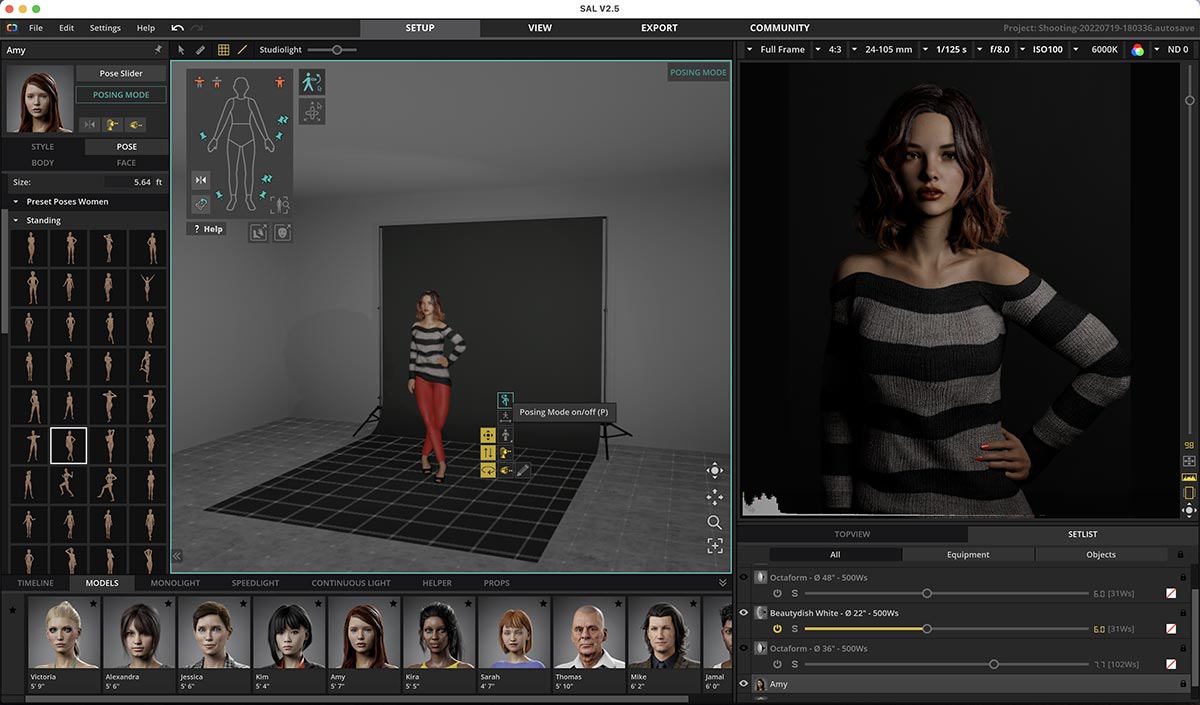
A variety of preset poses are included with set.a.light 3D as well as the option to create and save custom poses.
Lights
In real life, the number and variety of lights, modifiers and accessories in set.a.light 3D Studio could fill a warehouse. Lighting gear is broken down into monolights, speedlights, and continuous light sources/light panels (including Arri and KinoFlo models). There are also diffusion panels, reflectors, soft boxes, grids, gels, gobos, and barn doors. You can add custom speedlights, too. The addition of “practicals”—table and ceiling lamps and even a candle—is especially important for filmmakers. Of course, power adjustments are readily available for all lights.
X and Y axis, pitch, roll, yaw, and height of lights can all be adjusted to fit your setup. Light stands can be disabled and the light suspended to mimic using a boom. The broad scope of equipment covers pretty much any lighting scenario you can imagine. And with the recent addition of mirrors, there are even more tools to spark your creativity.
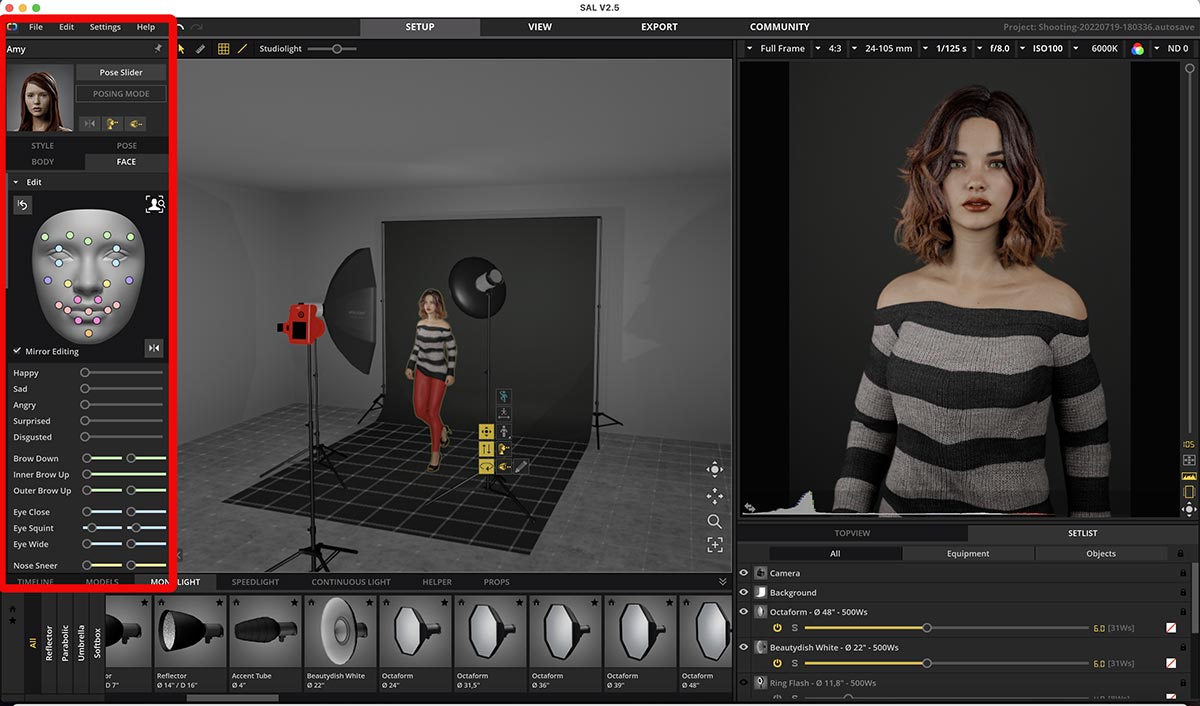
One of set.a.light 3D v2.5.8’s new features is the ability to change facial expressions.
Models, Clothing, and Props
Rounding out the software’s options are sets of models, clothing, and props. While I’d like to see a broader variety of genders and ages (especially younger kids for family portrait simulations), there are 10 models that cover most needs, including a pregnant model for maternity shoot simulations. More important, the software offers a large number of tools for changing everything from eye and skin color to hairstyle and clothing. Body shapes and sizes—even for individual body parts—can be adjusted to simulate a client’s physique.
Elixxier has included a large number of preset poses that can be applied with a single click. These are complemented by a pose slider that moves separate body parts at the joints for customization. For example, you can quickly change the position of a hand and individual fingers or the angle of a leg or the tilt of a head. Facial expressions can be modified as well. Better yet, custom models and facial expressions can be saved for future use.
Clothing options continue to grow with updates and variations for many of the individual components such as jackets, tops, and skirts. But I’d love to see some more modern styles and a set of formal outfits, including bridal wear, for wedding photographers.
Props run the gamut from furniture such as couches, beds, chairs, and tables to guitars, apple boxes, curtains, and food with cutting boards. Individual objects can be locked together to form tableaux, which can then be duplicated or moved as a single piece. The props may or may not come in handy to you, but they’re a nice addition and can help create more interesting setups.
New with this version is the addition of two cars. Although in beta, car headlights can be turned on and off, doors opened and closed, and the steering wheel turned. Expect more cool interaction with this prop in the near future. And keep your eyes open for a new animation tool.
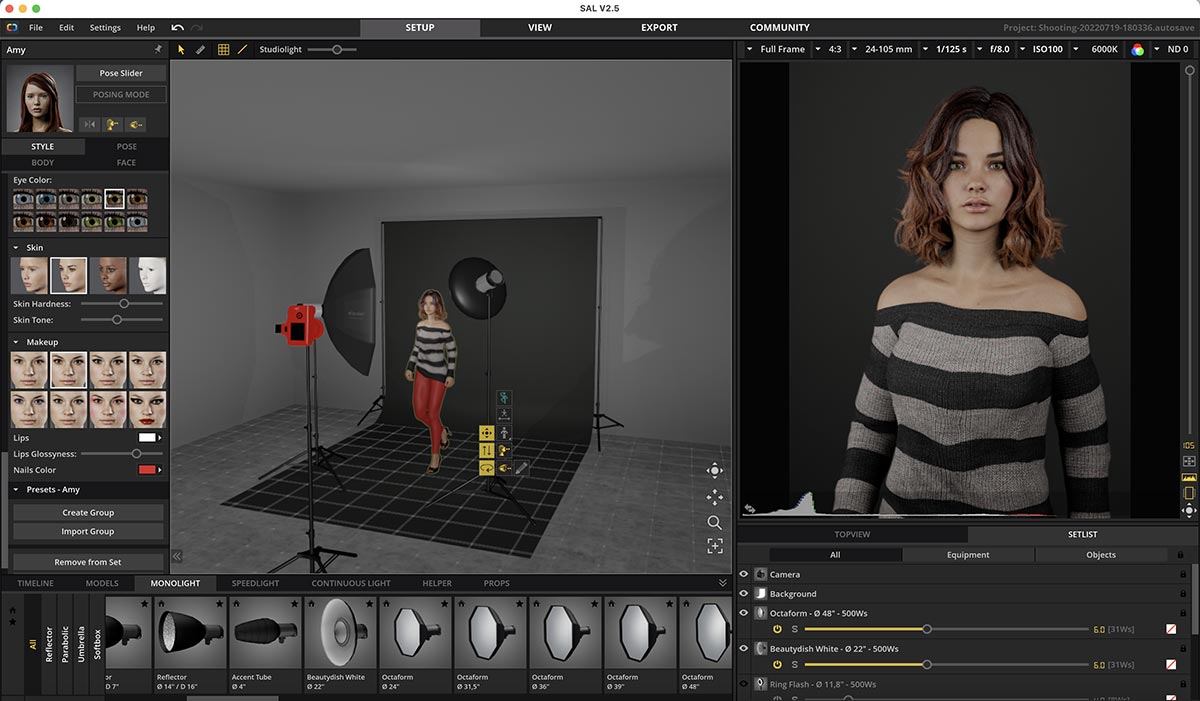
In addition to hair, clothing and makeup, model eye color and nail color can be customized.
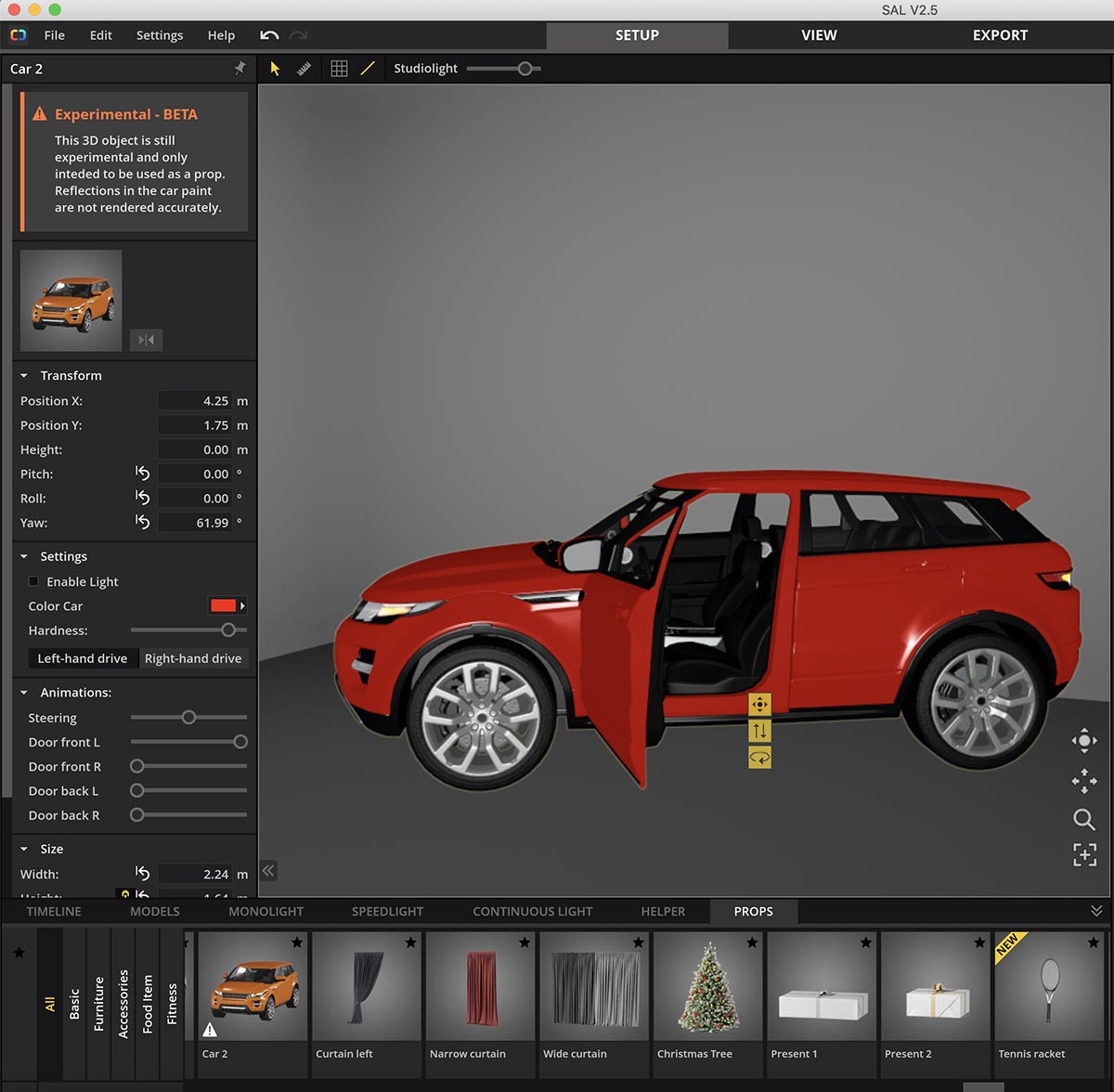
The car prop is new but still in Beta. Look for more animation and accurate light reflections in the future.
The Bottom Line
At its most basic, set.a.light 3D is drag-and-drop easy to use. The various elements (lights, models, props, etc.) are clearly marked and quickly accessed for an efficient workflow. Elixxier has a list of shortcuts that not only enhance the application’s efficiency but also allow users to get up to speed quickly. A downloadable manual and video tutorials on the Elixxier site are also helpful to discover some of the software’s less obvious but important options.
There is a learning curve, however, and working in 3D can be challenging. Be prepared to venture off on your own to discover features that are more difficult to unearth than others.
Regardless of your level of lighting expertise, set.a.light 3D is an excellent addition to your tool kit. The software provides a solid background in creative and practical lighting for photographers just starting out in studio lighting, while those with advanced skills will appreciate being able to preplan and save lighting setups to ensure successful shoots. And, frankly, set.a.light 3D is fun to use for experimenting, too.
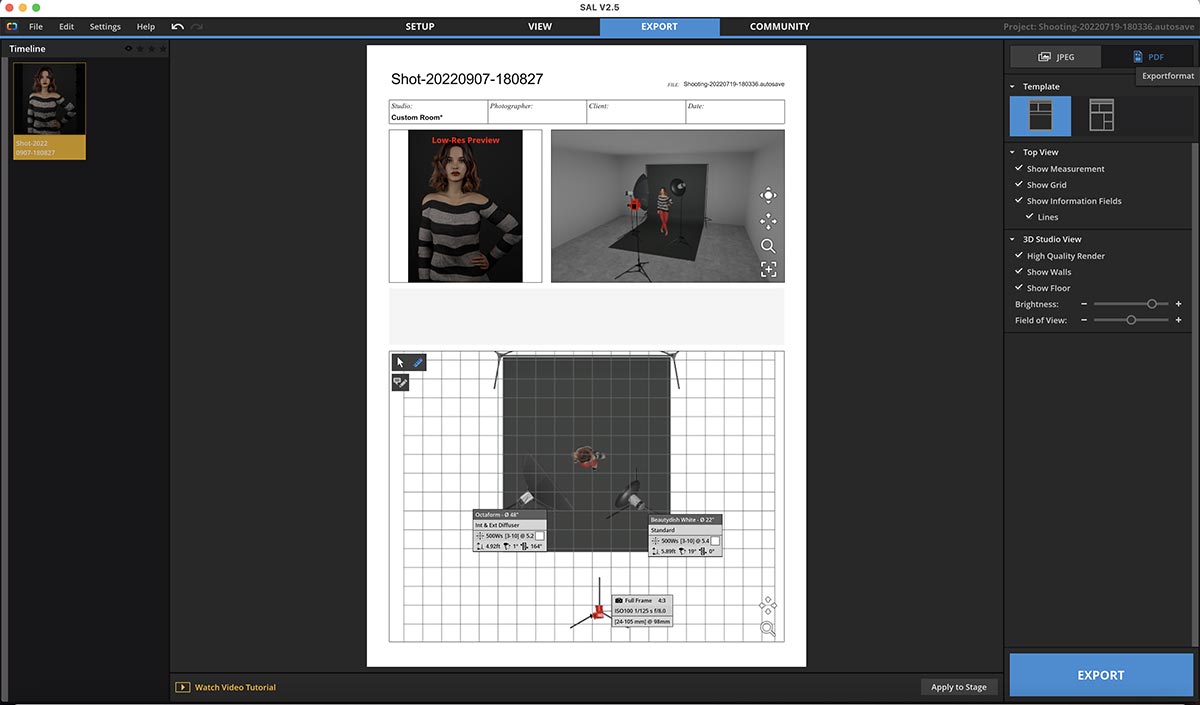
Detailed set plans can be saved, printed and shared to easily replicate the layout in studio.
Both the Basic and Studio versions are available for 15-day free trials. Before you take the economical route of purchasing the $94 Basic version, download the trial version to see if it has enough tools and flexibility to work for you. You can upgrade later, but if you’re serious about lighting, you might want to go all in with the full-featured $230 Studio version from the start.
Theano Nikitas has been writing about photography for more than 20 years.

